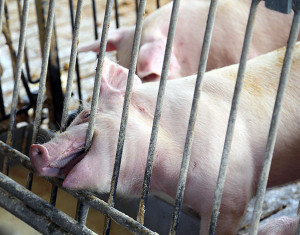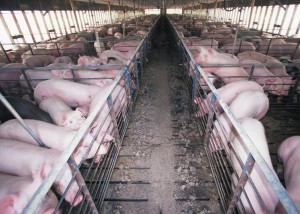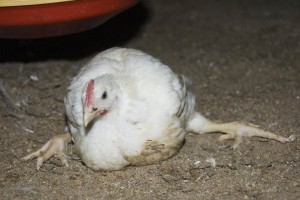People across the world are waking up to the impact of industrial farming systems on the health and welfare of billions of farmed animals. Recent research reveals that 69% of American shoppers now consider animal welfare as a key priority when buying their food.
Confinement: Bad for Animals

Over the last 50 years, the shift from small diverse family farms and grazing operations towards large confinement livestock operations has had a devastating impact on animal welfare across all farmed species. Modern confinement operations are designed to maximize growth and production rates in as short a time as possible. Today, most pigs, poultry and cattle in the U.S. are confined indoors or on dirt feedlots in cramped, stressful and often filthy conditions, where they are unable to express natural behaviors.
30 million beef cattle are slaughtered every year in the U.S. Most will have spent their last months at Concentrated Animal Feeding Operations (also known as CAFOs). Here, tens of thousands of cattle are confined together and reared to slaughter weight on vast dirt feedlots with no access to pasture or growing green vegetation. Instead, they are fed a diet designed to maximize weight gain—typically consisting of grain, corn by-products, animal by-products, cottonseed meal and alfalfa. According to the USDA, 5% of the largest feedlots are now responsible for finishing almost 90% of all U.S. beef cattle. The JR Simplot Company is reportedly the nation’s largest feedlot with 150,000 cattle on 750 acres.
Research shows that CAFOs are bad for cattle welfare. Cattle are ruminants and evolved to eat grass and forage. While feeding grain makes cattle grow faster, it makes them more susceptible to disease and frequently causes digestive problems, such as acidosis and feedlot bloat, responsible for over 500,000 premature cattle deaths in 2010. Up to 32% of all feedlot cattle suffer from liver abscesses, while respiratory diseases such as cattle pneumonia caused by the dusty conditions kill more than one million cattle a year. But instead of trying to prevent stress and illness, most industrial farming operations rely on routine antibiotics to prevent disease, resulting in the development of antibiotic-resistant bacteria (see our section on HUMAN HEALTH).
It’s a similar story for all other farmed species. According to the National Hog Farmer’s latest State of the Industry Report, almost 90% of the 115 million pigs slaughtered in the U.S. in 2014 were raised in confinement operations producing over 4,000 pigs a year. The largest operations hold over 50,000 pigs, confined in pens holding 20 or more animals, with no ability to root in the dirt, socialize or express other natural behaviors. Farrowing and gestation crates are still widely used in intensive pig systems, which severely restrict the ability of the sow to turn around, let alone move about and perform natural behaviors, leading to osteoporosis, joint pain, skin lesions and psychological problems. Sows in both types of crate are known to exhibit unnatural behaviors such as bar biting—a key sign of stress.
Almost nine billion broiler chickens are slaughtered every year in the U.S. In 2006, the average broiler operation produced over 600,000 birds a year. A typical broiler barn will hold 20,000-40,000 birds per production cycle, with five or six cycles a year. Each bird has about ¾ square foot of floor space during its short life—from chick to slaughter weight in six or seven weeks. Most broilers experience no sunlight, pasture or fresh air, and do not have the ability to express natural behaviors, such as nesting, foraging, dustbathing, pecking, running and flying. Broilers are raised in barns covered with “litter”—a mix of bedding materials (like wood shavings), feathers, excrement and waste feed. Once the birds have spent some time in the barn the ammonia in the litter builds up, which can lead to skin lesions (breast blisters, foot-pad and hock burns). Respiratory disease from poor air quality is also a big welfare problem in broiler production, affecting both birds and stockpersons.
Over 95% of the 303 million laying hens in the U.S. are still raised in battery cages, where hens are kept in wire cages in groups of about half a dozen, each with less than the area of a sheet of letter paper to live, leading to feather pecking and cannibalism (see below). The hens cannot hope to perform natural behaviors, such as nesting, perching, stretching wings, scratching and foraging in the soil, running or flying. Tens of thousands of hens are often kept in a single building. As if confinement in wire cages wasn’t enough, the concentration of ammonia from the hens’ feces causes serious respiratory problems.
The recent push to replace battery systems with so-called ‘enriched’ cages is misleading. ‘Enriched’ cages may offer slightly more room and are claimed to provide better welfare opportunities than a standard battery cage, but enriched cages are still confinement systems and provide very few potential benefits compared to standard cages, and in no way compare with the high-welfare, pasture-based systems supported by AGW certification, for example.
Re-designing the Animal: Mutilations
 Rather than design systems to suit the needs of the animal, the intensive farming industry often prefers to alter the animals to suit the farming system through painful mutilations. Perhaps the clearest example is the routine beak trimming of laying hens.
Rather than design systems to suit the needs of the animal, the intensive farming industry often prefers to alter the animals to suit the farming system through painful mutilations. Perhaps the clearest example is the routine beak trimming of laying hens.
One of the many welfare problems associated with caged egg production is cannibalism. In natural conditions, hens spend between 50–90% of their waking time foraging for insects and other feed on the ground, making up to 15,000 pecks a day. When birds are confined in cages they cannot practice this natural instinct and, as a result of frustration, often peck and attack each other, sometimes resulting in cannibalism. To control this behavior, part of the chick’s beak is cut or seared off to stop them from wounding other birds.
Intensively reared pigs routinely have their tails docked or cut off when they are a few days old to stop bored pigs kept in barren pens from chewing each other’s tails—a vice that can lead to serious infection. Another common practice on industrial pig farms is teeth clipping. Newborn piglets have sharp needle teeth, used to push past their litter mates when suckling, which can sometimes cause minor injuries to the sow and other piglets that can become infected. Aside from significant pain, teeth clipping young piglets can cause injury and mouth infections that stop the piglet suckling altogether.
Re-designing the Animal: Breeding Programs
 Over the last 50 years, the focus of industrial breeding programs to maximize productivity—to the near exclusion of all other traits—has had a hugely detrimental impact on the health and welfare of farmed animals. Nowhere is this more apparent than in broiler chickens.
Over the last 50 years, the focus of industrial breeding programs to maximize productivity—to the near exclusion of all other traits—has had a hugely detrimental impact on the health and welfare of farmed animals. Nowhere is this more apparent than in broiler chickens.
The Cornish-cross broiler chicken (pictured) is used extensively in industrial poultry operations. Developed in the 1980s, the aim was to produce a bird that basically sits and eats, grows quickly and produces a lot of breast meat. In 1920, a broiler chicken took 16 weeks to reach 2.2 lbs. Today, they can reach 5 lbs. in just seven weeks.
Research shows the Cornish-cross puts on weight faster than its body can bear, resulting in joint and ligament problems, including lameness. Selective breeding for growth also means the birds’ immune systems are often compromised, leaving them highly susceptible to gastroenterological problems, dermatitis, respiratory disease and sudden death. Many large broiler flocks are reliant on routine antibiotics to maintain productivity.
These welfare issues are not limited to poultry: Similar health and welfare problems are found in almost all intensively-farmed species bred for maximum productivity. In the early 1950s the average dairy cow produced about 5,300 pounds of milk a year. Today, the average annual milk yield per dairy cow is almost 22,500 pounds (2,650 gallons)—a more than quadrupling of milk yield per cow since the 1950s. Yet the selective breeding of dairy cows for maximum milk production has led to many welfare issues, including digestive and metabolic problems, lameness, mastitis (a painful udder infection) and infertility, as well as basic physiological stress. In a world of ever-increasing efficiency, the average U.S. dairy cow lives only 4.8 years before she is culled from the herd for loss of productivity, lameness or infertility. On some of the most intensive U.S. farms, a cow may only milk for two years before being culled.
Re-designing the Animal: Cloning
Cloning is a relatively new technique that proponents claim enables farmers to easily reproduce exact copies of high yielding cows or fast-growing pigs. It is estimated there are around 1,000 cloned cows and 300 cloned bulls out of the 100 million cattle in the U.S. While there is no mandatory requirement to register cloned animals, there is a voluntary ban on the marketing of meat and milk of cloned animals; however, this does not cover food (including meat) from the offspring of clones.
Although successful clones appear to be normal, there is clear evidence that cloning raises serious welfare concerns. The mortality of cloned animals is far higher than that of animals bred using other techniques. Most cloned embryos die during pregnancy, while a significant proportion die during or shortly after birth from cardiovascular failure, respiratory problems, liver or kidney failure, immune-deficiencies or musculoskeletal abnormalities. The reasons for these deaths are not well understood but the problems have appeared in all cloned species. Cloning may result in subtle genetic defects that could render animals more prone to health problems that may not show up until later in life.
There is currently no requirement for the milk and meat from the offspring of cloned animals to be labeled as being produced as a result of cloning technology. However, the Certified Animal Welfare Approved by AGW standards (the foundation of all of AGW livestock and poultry certifications) prohibit the use of cloning or the offspring of clones.
Re-designing the Animal: Genetic Engineering/Modification
To date no meat or other livestock products from genetically engineered (also known as genetically modified organisms or GMOs) animals has entered the human food chain, although over 70% of U.S. processed food now contains GMO crop ingredients (mainly soy, canola and maize). However, this doesn’t mean there are no GMO animals in existence. AquaBounty Technology’s plan to market a GMO salmon (modified to include a Chinook salmon gene to reach a marketable weight in half the time of conventional salmon) could be the start of a new wave of GMO animals for human consumption—including cattle, sheep, pigs, chickens and goats.
While GMO crops raise important questions for the environment and (potentially) human health, GMO animals also raise real animal welfare concerns. Over the last two decades, research on GMO farm animals has increased dramatically across the world. In the UK, dairy cattle were engineered to express an antibiotic in their milk to improve resistance to mastitis, a common disease in intensive dairy systems. Scientists are also trying to create GMO pigs with reduced phosphate levels in their feces to minimize associated pollution risks. In 2011, Chinese researchers successfully introduced human genes into dairy cows to produce milk that was closer in composition to human breast milk to avoid food allergy problems.
Although genetic engineering does not automatically result in welfare issues for the animals concerned, there is sufficient evidence to raise significant questions. While investigating GMO fish, Canadian researchers found “deleterious consequences to fish morphology, respiratory capacity, and locomotion associated with the introduction of growth hormone (GH) gene constructs in some transgenic variants of salmonids.” High mortality is also a common feature of GMO experimentation. According to the Nuffield Council on Bioethics, there is only a 3–5% success rate when generating new GMO animals. Many engineered embryos die in gestation or shortly after birth, often as a result of unexplained health problems, while adverse effects may only become apparent later in the animals’ life or when they are exposed to other stress factors.
A wider question is the justification—or need—for GMO animals. Should animals be genetically engineered simply to address problems that are either directly or indirectly the result of intensive farming? Particularly when alternative approaches, such as improved husbandry practices or non-GMO breeding techniques, could achieve the same results without the associated welfare risks?
Proponents of GMO technology often claim the technology is necessary to feed future global populations. But we need to ask ourselves whether genetically engineering a livestock species simply to fuel our unsustainable demand for so-called ‘cheap’ meat and livestock products, or to mask the underlying failings of industrial farming systems, can ever be justified, and whether it is right to view animals as mere units of production to be exploited regardless of the cost.
TAKE POSITIVE ACTION
At AGW, we believe the way we farm, the nutritional quality of our food, and the impact of farming systems on wildlife, the environment and wider society are all connected. Raise animals in poor conditions and poor welfare standards, and you’re going to get unhealthy food that’s also bad for the environment.
By supporting farmers who are Certified Animal Welfare Approved by AGW, Certified Grassfed by AGW and Certified Non-GMO by AGW, you can be sure you’re buying meat, eggs and dairy from independent farms where animals are raised outdoors on pasture or range for their entire lives according to the highest welfare standards in North America. That’s better for us, better for the farmers, better for the animals and better for the planet.
Next:
Industrial farming also has negative impacts on the people who raise and process our food…
Be part of the solution:
Find out how your daily food choices can help fix our food system here!
